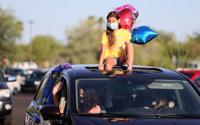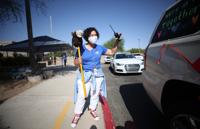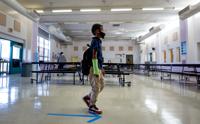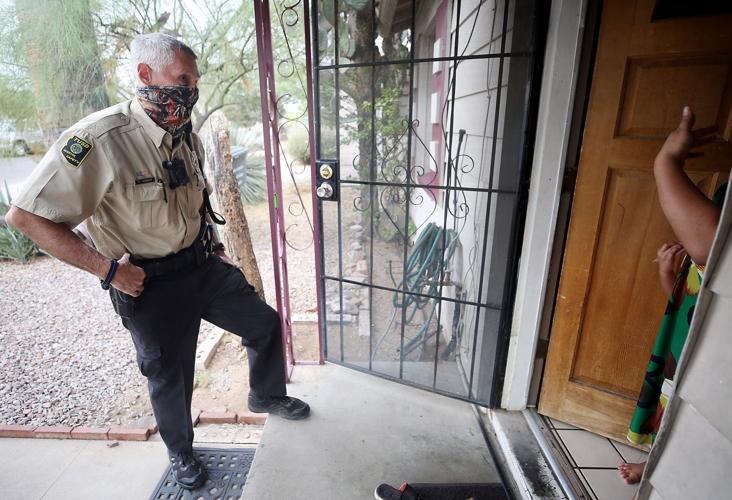A Tucson teacher calls 911 after a student on Zoom flashes what appears to be a handgun.
Another teacher realizes that her young student and a sibling had been fending for themselves as their single mother was bedridden with COVID-19.
Then there’s a parent with several children struggling with online school who says the district keeps calling, and it’s starting to feel like harassment.
Meanwhile, local police are finding more children and teens in the mix when they answer domestic violence calls, investigate drug cases and fatal drug overdoses.
These are just a few glimpses at what the coronavirus pandemic has wrought in the lives of Tucson’s vulnerable families, children and teens. The Arizona Daily Star conducted an online survey of about 150 teachers and parents to learn what they are seeing and experiencing.
It’s unclear what’s happening in the lives of well over 1,100 young people who never show up for online school or only attend sporadically. While numbers from the Vail and Tucson Unified school districts were not provided for this news article, the combined total of students unaccounted for in Tucson’s seven other major school districts is at least 1,160, with some students missing since last spring.
That number increases dramatically if students who attend school very sporadically are included.
There’s no specific mechanism in place to find them and make sure they are OK.
Instead, checking on missing kids is falling to school administrators, teachers and staff during a pandemic that already has these workers bringing students school supplies, computers and food, as well as answering late-night calls and texts from parents, acting as personal tech support and even connecting families to mental health services. On top of that, school workers are trying to care for their own families while working in schools with coronavirus cases — or knowing the virus could come soon — and often holding down a second job.
Teachers are mandatory reporters of child abuse. Attendance in the time of COVID-19 is sporadic for many reasons that don’t rise to the level of abuse or neglect, but with teachers not seeing many of their students in person, red flags are much harder to spot.
Stress can lead to abuse
On average, calls to an abuse hotline run by Arizona’s Department of Child Services are down 25% to 30%. Mike Faust, the agency’s director, attributes the decrease largely to schools not being held in person.
This lack of oversight by teachers and administrators is happening at a time when families and parents are under tremendous stress due to layoffs, social isolation and, sometimes, illness.
Research by the federal Substance Abuse and Mental Health Services Administration shows that increased stress among parents is a predictor of physical abuse and neglect of children.
Stressed parents may be more likely to respond to their children’s behaviors in aggressive or abusive ways. The support systems that many rely on, such as extended family, child care and schools, religious groups and other community organizations, are no longer available due to COVID-19.
How commonly this translates to actual abuse or neglect that requires intervention is difficult to determine.
As it currently stands, state law does not permit DCS to use a child’s school attendance record as the sole basis for investigating a report. In other words, teachers and school administrators cannot call DCS just because a student has been chronically absent.
However, local law enforcement has authority to conduct a welfare check in that circumstance, DCS spokesman Darren DaRonco wrote in an email to the Arizona Daily Star.
DaRonco said problems with school attendance in Arizona due to COVID-19 are a significant concern, and that teachers are “vital to ensuring kids are free from abuse and neglect.”
Working to find missing students
Tucson’s largest school district, TUSD, is still working to identify how many kids have fallen off the radar. That means the number of unaccounted for children is likely much higher than the 1,160 number coming out of the other school districts across the county.
TUSD has had an enrollment decline of 2,600 students since this time last year. Many of those students have gone to charter or private schools that are offering in-person learning, switched to homeschooling or moved out of the city to live with family due to economic hardship.
TUSD Superintendent Gabriel Trujillo said there is also a category of students who are just not in school at all. Then there are those students TUSD can’t find despite repeated phone calls and even home visits.
“We are still working diligently to get a hold of families that have not responded,” Trujillo said. “Not having a detailed accounting of every single student that hasn’t responded to us is largely a function of them disappearing and not answering phone calls and having phone numbers disconnected.”
TUSD hopes to locate more students in the coming weeks as teams continue to reach out to secondary and emergency contacts, he said.
Amphitheater Unified has seen the largest enrollment percentage drop in the county. Its enrollment drop accounts for losing about 1,800 students from last year. Of those students, between 500 and 600 are unaccounted for.
“We actually have no idea where they are,” said Amphitheater Superintendent Todd Jaeger. “Wherever they went, the receiving school did not request their records or anything like that so we don’t have a connection as to those specific students. That’s a significant number.”
Vail is the only other local district besides TUSD that hasn’t compiled a number of how many students are unaccounted for. But Vail does know that about 300 students dropped enrollment for home schooling.
Another way to gauge how kids are doing is to look at enrollment for Tucson’s Youth on Their Own, which works to address teen homelessness. Its numbers are down by half, with about 750 homeless youth enrolled so far this year compared to 1,500 last year, said the organization’s CEO, Elizabeth Slater.
Slater said they are making progress with finding and enrolling students but says this initial gap “speaks to the impact of vulnerable youth being disconnected from school and the many community-based support services, like YOTO, that reach students through their schools.”
Homeless youth are overrepresented when it comes to young people not in school during the pandemic, she said. Access to internet services and technology is a part of it, she said, and they are trying to reach young people who need help with either.
“It’s a huge challenge, and we’re trying to partner with each district to try to get students back and engaged in schools,” Slater said. For a teen to be enrolled in YOTO, school attendance is the number one requirement.
“We’ve never had to recruit our students,” Slater said. “Usually we’re overwhelmed by requests for support.”
Domestic violence cases rise; child abuse cases drop
Tucson Police Officer Roman Acosta says he’s responding to the same type of calls as he patrols neighborhoods on Tucson’s southwest side. What’s different now: Kids are more likely to be home when he arrives.
And for certain types of calls, like domestic violence, Acosta is mandated to report his observations to the Arizona’s DCS.
Statewide, as reports to DCS by teachers dropped dramatically, calls by law enforcement have increased as much as 20% each week for the last few months.
The number of calls for neglect, physical abuse and sexual abuse have climbed each month since July, with 2,411 calls for neglect in July compared to 2,754 in September, data from DCS show.
Calls about physical abuse rose from 848 to 1,174, and calls about sexual abuse rose from 140 to 179 for those two months.
Over the same time, the number of children newly put into state care in Arizona rose from 775 in July to 964 in September, for a total of 13,485 children in out-of-home care that month.
As a supervisor with TPD’s domestic violence unit, Sgt. Joseph Wall said they saw a noticeable increase in domestic violence cases with the stay-at-home order that started in mid-March. The trend has continued since then.
“The domestic violence incidents have not only been on the rise, but also the amount of violence has been on the rise as well,” he said, explaining that the use of weapons such as firearms and knives have increased.
To illustrate the difference, Wall said, they just need to go back a year: There were 5,273 reported incidents of domestic violence between Jan. 1 and Aug. 31, 2019, he said. For the same time period this year it has been 6,750 reported incidents, a 28% increase.
And for felony domestic violence involving aggravated assault, there were 469 cases in 2019 compared to 668 this year, a 42% increase.
Patrol officers are seeing a lot of child neglect, said Sgt. Lauren Pettey, who supervises TPD’s child physical abuse unit. This, she says, could be correlated with what else they’ve seen increase: People struggling with drug and alcohol misuse and addiction.
But Pettey said it’s hard to know what’s going on in families facing extreme hardships due to COVID-19. Teachers have made only a handful of calls for welfare checks, she said.
In fact, in her unit — which investigates all crimes against children except sex crimes — it’s not the increase that’s noticeable, but the drop in cases overall.
The number of cases that have come through her department this year, from March 1 to Oct. 31, was 796 compared to 848 during the same period last year, a 6% decrease.
“A euphemism for investigation”
For people who believe Arizona’s child welfare system is already overly involved in people’s lives, the idea of having DCS do welfare checks on absentee children is unwelcome.
DCS is a policing agency, said Richard Wexler, director of the National Coalition for Child Welfare Reform, and “a welfare check is a euphemism for investigation.” He said having the DCS get involved will only add to family stress, unfairly target communities of color and prevent families from seeking voluntary help.
“I give DCS credit for refusing to engage in what actually would be a campaign of harassment against poor families,” said Wexler. “And yes, it will be poor families: Schools will not be calling in child abuse reports on kids who aren’t attending school in (wealthy areas).”
Parents and teachers who answered the Star’s survey, many on the condition of anonymity, have had their own observations about missing students and hold a variety of opinions about what could be done to help. Many teachers are worried about missing students, with one sharing that as many as 70% of her students might not show up on any given day.
Several parents were against the DCS or law enforcement involvement, with one parent writing that involving those entities would “scare many families, especially families with no legal status in the U.S. Principals or school nurses, or other staff would be much more appropriate.”
Others were in favor of more intervention.
“Something should be done to check on the children missing their classes,” another parent wrote. “It could be caused by abuse, lack of housing, lack of utilities, lack of parental education, language or learning barriers, or they could be home alone because their parents have to work, the reasons can pile up quickly in these difficult times.”
No way of knowing of possible abuse
In the absence of DCS checking on children, schools are doing it themselves, and in many cases individual teachers are doing so.
Wright Elementary teachers and staff are reaching out to absent kids daily, says Principal Deanna Campos.
Apart from high risk children in on-campus learning spaces, TUSD students are doing remote learning.
As in many schools, some kids at Wright log in to classes sporadically, and others don’t show up at all. Teachers and staff at the school call DCS when they can’t reach kids, and Campos says the typical response is: “Sorry, we are not doing anything with truancy.”
Before coronavirus, teachers at Wright called DCS about twice a week when they would spot a red flag, including visible signs of abuse or neglect.
In the absence of seeing the kids in person, one way of knowing that something may be wrong is if the kids aren’t signing into class.
“Now we really have no way of knowing if there’s any abuse going on,” Campos said.
Despite concerted and sustained efforts to reach absent kids every day, the school has been unable to reach about 10 children.
“Arizona has the law where you have to go to school, but there’s no accountability for that,” Campos said. “You can call DCS, and nothing happens. You can call the police — that’s a joke.”
Campos says if police have time, they will do a well check, but it’s low priority.
Wright kindergarten teacher Tammy Nelson is very worried about the well-being of some of her students.
Signs a teacher sees in person that a child could be in trouble are different than over a computer.
Nelson says these signs include what she hears going on in a child’s home, no adult being available to help a child, or a student being frequently unkempt, dirty or not having the tools they need to do school work although the teacher or school has dropped off packets of school supplies and supplied the necessary technology.
Nelson has made several reports to DCS this year — too many, she says. She only knows of one that was followed up on. She also called the police department to do welfare checks, but said it hasn’t seemed to make a difference.
Wright’s school safety officer went out to the homes of the kids who the school hadn’t been able to locate at all. In some cases, families were having technology issues or the parents were just too overwhelmed to ensure that their children regularly signed into class.
And in some cases, no one answered the door.
Many teachers who answered the Arizona Daily Star’s survey said they had trouble reaching children while others said they’ve been successful reaching their whole class through consistent outreach efforts.
One respondent said five students in the class were missing despite a concerted and sustained effort to reach them. Other respondents said their school had staff or a resource officer who would make house visits to students who couldn’t be reached.
Nelson has dealt with frequent absences that don’t rise to the level of calling for a welfare check.
Students show up sporadically or not at all because parents are overwhelmed, oftentimes they’re working, have many children in the house, or are struggling with issues that push their child’s education to the back burner.
“It just boils down to the parents’ personal issues — mental, emotional, physical, whatever circumstances,” Nelson says. “Just taking a kid to school and dropping them off is just the easiest way.”
Also, kids with working parents who spend the day in a day care often don’t have the support they need to succeed because day cares are also stretched thin, Nelson says.
Nelson sees many parents doing the best they can but says it’s often not enough to keep their students on track academically.
“Everyone’s doing the best that they can with what they have, and we all need to grant everybody a little bit of grace,” Nelson says. “We need to make sure that our kids are protected and in a safe environment, especially if we’re seen as mandated reporters.”
Struggling parents making due
Remote learning has been hard for Clare Cox’s son, who has special needs. He has a hard time focusing on a computer screen for long periods. Before the pandemic, he had a one-on-one aid in school. The responsibility of keeping him on task at school falls to Cox now.
But the TUSD mom says she’s making it work. She has a first-grader as well, who can work independently. Cox works in the evening from home, allowing her to help her son during the day.
She’s in regular communication with her son’s teachers at Borton Magnet Elementary, and says they have been very flexible to support his needs.
“The teachers know if he’s disappeared from his screen then he’s taking a break and he’ll be back,” Cox said. “Or I’ll text the teacher and say, ‘Look, he’s just chilling in his room for a little while. He’ll be back.’ So we have made it work.”
She and her husband even tested positive for COVID-19 two weeks ago, and it was rough. Even with body aches and fatigue, she kept in communication with her children’s school about what was going on.
Cox sees other kids in her son’s class are with grandparents or other relatives. And she says if she and her husband both had to work out of the home during the day, she doesn’t know how they would manage it all.
Grace Howard, who has a freshman in the Marana School District, is pretty much over doing hybrid learning — in-person classes two days a week and virtual ones the other three days.
She takes her daughter to work with her on the remote-learning days, but says constant technical problems have led to her daughter missing more than 20 days of school and failing her classes.
Her daughter has special needs and isn’t getting the instruction she needs to succeed, Howard says.
“We do everything now”
On Veteran’s Day, Nelson was still in her pajamas at noon. It was supposed to be a day off, but the Wright kindergarten teacher had been working all morning on lesson plans and new strategies to engage 5-year-olds over a computer for hours a day.
Every moment of the day is spent on her students and their families.
Nelson has taken multitasking to a new level. She leads kids in a song while answering parent emails. She dances with the kids while taking roll.
And she often goes to bed at 8 p.m., exhausted.
“There is no work-life balance,” she says. “And it’s kindergarten — it’s not rocket science. These are 4- and 5-year-olds. But you want to give them your everything. You want to give them the world. We’re the building blocks for their next 12 years. And so I’m gonna do my darndest to help them.”
Many teachers say all their parents have their phone numbers and are in touch with them at all times of day and night.
One teacher who responded to the Star’s survey said she texts guardians all the time and goes to homes to deliver supplies — added duties on top of regularly scheduled class time. Many teachers are doing this.
Like in other public schools, Wright’s families come to them for winter jackets, Thanksgiving turkeys and Christmas presents for their kids. Campos, the principal, has long gone above and beyond to provide for her families, but the need is increasing and much of it falls to schools.
“Sometimes it’s a little overwhelming,” Campos says. “We’re a school, but we do everything now.”
Photos: Back-to-school in Tucson during the pandemic
"Mustang Stampede"
Updated
Maddy Jacobs, 7, middle, reaches for her remote learning tool kit from her teacher, Kris Green, as her friend, Carly Kupinski, 6, watches during a "Mustang Stampede" at Manzanita Elementary School for the first day of school on August 17, 2020.
First Day of School, John B. Wright Elementary
Updated
Augusta Iranzi, center, attends his teachers online class while monitors Jasmine Phillip, left, and Nadifo Yusuf, watch students inside a classroom at John B. Wright Elementary School, 4311 E. Linden St., in Tucson, Ariz. on August 17, 2020. About 10 students came to school for online instruction under the guidance of classroom monitors.
"Mustang Stampede"
Updated
Lily Baser, 8, identifies herself for easy remote learning tool kit pickup during a "Mustang Stampede" at Manzanita Elementary School for the first day of school on August 17, 2020.
"Mustang Stampede"
Updated
Krista Westmoreland, left, a third grade teacher, shows the remote learning tool kit of a student to Anna Ames, music teacher, during the "Mustang Stampede" at Manzanita Elementary School for the first day of school on August 17, 2020.
"Mustang Stampede"
Updated
Maya Brown, 9, rides in style for her remote learning tool kit pickup during a "Mustang Stampede" at Manzanita Elementary School for the first day of school on August 17, 2020.
"Mustang Stampede"
Updated
Multiage teachers Kris Green left, and April Pollow greet and cheer on their students during a "Mustang Stampede" at Manzanita Elementary School for the first day of school on August 17, 2020.
"Mustang Stampede"
Updated
Maddy Jacobs, 7, left, waves to her teacher as she stands in the sunroof with her friend, Carly Kupinski, 6, during a "Mustang Stampede" to pickup their remote learning tool kit at Manzanita Elementary School for the first day of school on August 17, 2020.
"Mustang Stampede"
Updated
For the first day of school teachers at Manzanita Elementary School greeted their students during a "Mustang Stampede" and handed out remote learning tool kits on August 17, 2020.
"Mustang Stampede"
Updated
Kim Boling, principal at Manzanita Elementary School, greets her students and parents with a mustang during the "Mustang Stampede" for the first day of school on August 17, 2020.
First Day of School, John B. Wright Elementary
Updated
Yarani Martinez gives a monitor a thumbs up to inform the monitor that his online class is working after classes began at John B. Wright Elementary School, 4311 E. Linden St., in Tucson, Ariz. on August 17, 2020. About 10 students came to school for online instruction under the guidance of classroom monitors.
First Day of School, John B. Wright Elementary
Updated
Alice Flores, right, watches as her grandson Jesus Silva is escorted to the cafeteria before classes began at John B. Wright Elementary School, 4311 E. Linden St., in Tucson, Ariz. on August 17, 2020. About 10 students came to school for online instruction under the guidance of classroom monitors.
First Day of School, John B. Wright Elementary
Updated
Augusta Iranzi follows the directions on the floor while being escorted to a classroom at John B. Wright Elementary School, 4311 E. Linden St., in Tucson, Ariz. on August 17, 2020. About 10 students came to school for online instruction under the guidance of classroom monitors.





